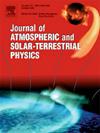Vertical acoustic resonance in the atmosphere as a source of Pc5 geomagnetic pulsations
IF 1.9
4区 地球科学
Q3 GEOCHEMISTRY & GEOPHYSICS
Journal of Atmospheric and Solar-Terrestrial Physics
Pub Date : 2025-04-10
DOI:10.1016/j.jastp.2025.106511
引用次数: 0
Abstract
Some strong earthquakes and volcano eruptions are accompanied by atmospheric pressure variations and geomagnetic perturbations (GMPs), which contain spectral spikes in the Pc5 frequency range. GMPs are usually observed in epicentral areas of several hundred kilometers in size and in a geomagnetically conjugated region. This effect can be explained by the impact on the ionosphere of an atmospheric acoustic wave caused by seismic vibration of the earth's surface. A partial reflection of the acoustic wave from the region of a sharp change in atmospheric temperature near the bottom of the thermosphere can lead to a vertical acoustic resonance (VAR) in the area between the earth's surface and the thermosphere boundary. The acoustic wave partially penetrates into the ionosphere, thereby exciting ionospheric currents and GMPs in the Pc5 frequency range. In this study we develop a plane-stratified model of the atmosphere and ionosphere in order to examine spectrum of the first VAR harmonics. A set of 2D gas dynamics equations is treated to derive dispersion relations which determine the VAR resonant frequencies. Ionospheric currents and GMP are found in the approximation of a thin ionospheric E-layer with an inclined geomagnetic field. Analysis of the VAR dispersion relation shows that the resonant frequencies of the first three harmonics lies within 3.7−5.9 mHz, that is, in the Pc5 frequency range, while their logarithmic decrements range from zero to 0.6. The weak attenuation of VAR harmonics can explain the observed long duration of VAR and GMPs after a seismic event. Unlike previous studies, the effect of wind in the upper atmosphere is taken into account. It has been found that wind velocity weakly influences the resonant frequencies but it may greatly affect the attenuation coefficients of VAR harmonics. The model predicts a similar shape of GMPs detected near the epicenter of strong seismic events and in the magnetically conjugated arears, which is consistent with geomagnetic response to VAR detected by ground-based magnetometers.
大气中的垂直声共振作为Pc5地磁脉动的来源
一些强震和火山爆发伴随着大气压力变化和地磁扰动(gmp),它们包含在Pc5频率范围内的频谱峰值。通常在几百公里大小的震中区域和地磁共轭区域观察到gmp。这种效应可以用地球表面地震振动引起的大气声波对电离层的影响来解释。在靠近热层底部的大气温度急剧变化区域,声波的部分反射会导致地球表面和热层边界之间的垂直声共振(VAR)。声波部分穿透电离层,从而激发电离层电流和Pc5频率范围内的gmp。在这项研究中,我们开发了一个大气和电离层的平面分层模型,以检查第一次VAR谐波的频谱。利用一组二维气体动力学方程,导出了确定无功共振频率的色散关系。电离层电流和GMP是在一个倾斜地磁场的电离层e层的近似中发现的。分析VAR色散关系可知,前三个谐波的谐振频率在3.7 ~ 5.9 mHz范围内,即Pc5频率范围内,其对数衰减范围为0 ~ 0.6。VAR谐波的弱衰减可以解释地震后观测到的VAR和gmp持续时间较长。与以往的研究不同,这次研究考虑了高层大气中风的影响。研究发现,风速对谐振频率的影响较小,但对无功谐波的衰减系数影响较大。该模型预测,在强震事件震中附近和磁共轭区域检测到的gmp形状类似,这与地面磁力计检测到的VAR地磁响应一致。
本文章由计算机程序翻译,如有差异,请以英文原文为准。
求助全文
约1分钟内获得全文
求助全文
来源期刊

Journal of Atmospheric and Solar-Terrestrial Physics
地学-地球化学与地球物理
CiteScore
4.10
自引率
5.30%
发文量
95
审稿时长
6 months
期刊介绍:
The Journal of Atmospheric and Solar-Terrestrial Physics (JASTP) is an international journal concerned with the inter-disciplinary science of the Earth''s atmospheric and space environment, especially the highly varied and highly variable physical phenomena that occur in this natural laboratory and the processes that couple them.
The journal covers the physical processes operating in the troposphere, stratosphere, mesosphere, thermosphere, ionosphere, magnetosphere, the Sun, interplanetary medium, and heliosphere. Phenomena occurring in other "spheres", solar influences on climate, and supporting laboratory measurements are also considered. The journal deals especially with the coupling between the different regions.
Solar flares, coronal mass ejections, and other energetic events on the Sun create interesting and important perturbations in the near-Earth space environment. The physics of such "space weather" is central to the Journal of Atmospheric and Solar-Terrestrial Physics and the journal welcomes papers that lead in the direction of a predictive understanding of the coupled system. Regarding the upper atmosphere, the subjects of aeronomy, geomagnetism and geoelectricity, auroral phenomena, radio wave propagation, and plasma instabilities, are examples within the broad field of solar-terrestrial physics which emphasise the energy exchange between the solar wind, the magnetospheric and ionospheric plasmas, and the neutral gas. In the lower atmosphere, topics covered range from mesoscale to global scale dynamics, to atmospheric electricity, lightning and its effects, and to anthropogenic changes.
 求助内容:
求助内容: 应助结果提醒方式:
应助结果提醒方式:


